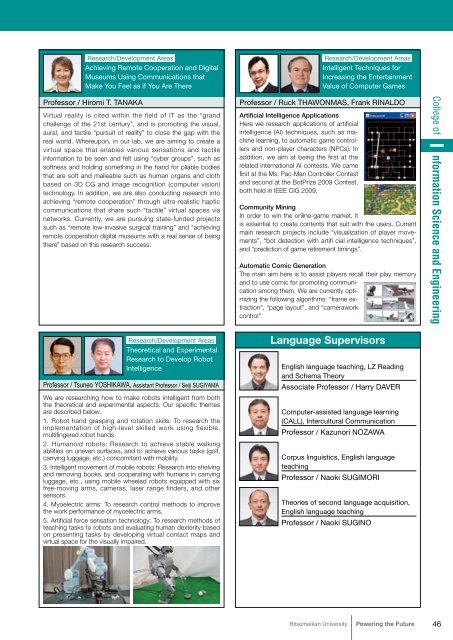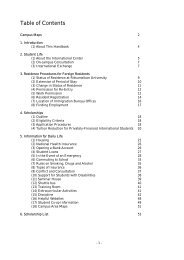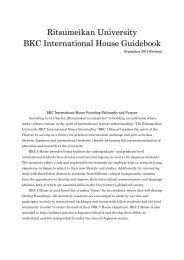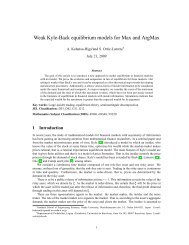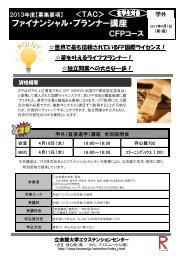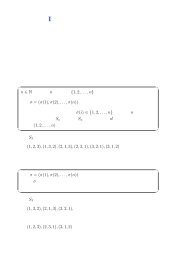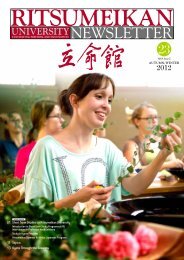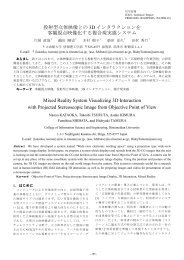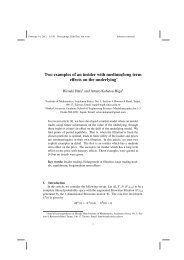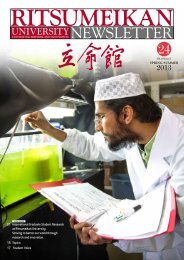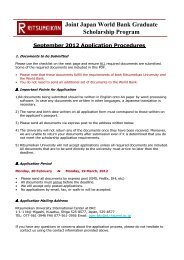Powering the Future - 立命館大学
Powering the Future - 立命館大学
Powering the Future - 立命館大学
You also want an ePaper? Increase the reach of your titles
YUMPU automatically turns print PDFs into web optimized ePapers that Google loves.
Research/Development Areas<br />
Achieving Remote Cooperation and Digital<br />
Museums Using Communications that<br />
Make You Feel as if You Are There<br />
Research/Development Areas<br />
Intelligent Techniques for<br />
Increasing <strong>the</strong> Entertainment<br />
Value of Computer Games<br />
Professor / Hiromi T. TANAKA<br />
Virtual reality is cited within <strong>the</strong> field of IT as <strong>the</strong> “grand<br />
challenge of <strong>the</strong> 21st century”, and is promoting <strong>the</strong> visual,<br />
aural, and tactile “pursuit of reality” to close <strong>the</strong> gap with <strong>the</strong><br />
real world. Whereupon, in our lab, we are aiming to create a<br />
virtual space that enables various sensations and tactile<br />
information to be seen and felt using “cyber groups”, such as<br />
softness and holding something in <strong>the</strong> hand for pliable bodies<br />
that are soft and malleable such as human organs and cloth<br />
based on 3D CG and image recognition (computer vision)<br />
technology. In addition, we are also conducting research into<br />
achieving “remote cooperation” through ultra-realistic haptic<br />
communications that share such “tactile” virtual spaces via<br />
networks. Currently, we are pursuing state-funded projects<br />
such as “remote low-invasive surgical training” and “achieving<br />
remote cooperation digital museums with a real sense of being<br />
<strong>the</strong>re” based on this research success.<br />
Professor / Ruck THAWONMAS, Frank RINALDO<br />
Artificial Intelligence Applications<br />
Here we research applications of artificial<br />
intelligence (AI) techniques, such as machine<br />
learning, to automatic game controllers<br />
and non-player characters (NPCs). In<br />
addition, we aim at being <strong>the</strong> first at <strong>the</strong><br />
related international AI contests. We came<br />
first at <strong>the</strong> Ms. Pac-Man Controller Contest<br />
and second at <strong>the</strong> BotPrize 2009 Contest,<br />
both held in IEEE CIG 2009.<br />
Community Mining<br />
In order to win <strong>the</strong> online-game market, it<br />
is essential to create contents that suit with <strong>the</strong> users. Current<br />
main research projects include “visualization of player movements”,<br />
“bot detection with artifi cial intelligence techniques”,<br />
and “prediction of game retirement timings”.<br />
Automatic Comic Generation<br />
The main aim here is to assist players recall <strong>the</strong>ir play memory<br />
and to use comic for promoting communication<br />
among <strong>the</strong>m. We are currently optimizing<br />
<strong>the</strong> following algorithms: “frame extraction”,<br />
“page layout”, and “camerawork<br />
control”.<br />
College of I nformation Science and Engineering<br />
Research/Development Areas<br />
Theoretical and Experimental<br />
Research to Develop Robot<br />
Intelligence<br />
Professor / Tsuneo YOSHIKAWA, Assistant Professor / Seiji SUGIYAMA<br />
We are researching how to make robots intelligent from both<br />
<strong>the</strong> <strong>the</strong>oretical and experimental aspects. Our specific <strong>the</strong>mes<br />
are described below.<br />
1. Robot hand grasping and rotation skills: To research <strong>the</strong><br />
implementation of high-level skilled work using flexible,<br />
multifingered robot hands.<br />
2. Humanoid robots: Research to achieve stable walking<br />
abilities on uneven surfaces, and to achieve various tasks (golf,<br />
carrying luggage, etc.) concomitant with mobility.<br />
3. Intelligent movement of mobile robots: Research into shelving<br />
and removing books, and cooperating with humans in carrying<br />
luggage, etc., using mobile wheeled robots equipped with six<br />
free-moving arms, cameras, laser range finders, and o<strong>the</strong>r<br />
sensors.<br />
4. Myoelectric arms: To research control methods to improve<br />
<strong>the</strong> work performance of myoelectric arms.<br />
5. Artificial force sensation technology: To research methods of<br />
teaching tasks to robots and evaluating human dexterity based<br />
on presenting tasks by developing virtual contact maps and<br />
virtual space for <strong>the</strong> visually impaired.<br />
Language Supervisors<br />
English language teaching, LZ Reading<br />
and Schema Theory<br />
Associate Professor / Harry DAVER<br />
Computer-assisted language learning<br />
(CALL), Intercultural Communication<br />
Professor / Kazunori NOZAWA<br />
Corpus linguistics, English language<br />
teaching<br />
Professor / Naoki SUGIMORI<br />
Theories of second language acquisition,<br />
English language teaching<br />
Professor / Naoki SUGINO<br />
Ritsumeikan University<br />
<strong>Powering</strong> <strong>the</strong> <strong>Future</strong><br />
46


